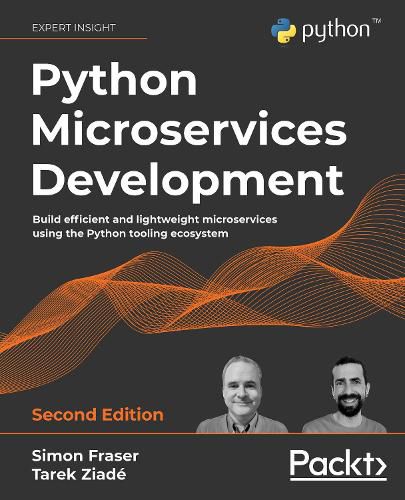Readings Newsletter
Become a Readings Member to make your shopping experience even easier.
Sign in or sign up for free!
You’re not far away from qualifying for FREE standard shipping within Australia
You’ve qualified for FREE standard shipping within Australia
The cart is loading…






This title is printed to order. This book may have been self-published. If so, we cannot guarantee the quality of the content. In the main most books will have gone through the editing process however some may not. We therefore suggest that you be aware of this before ordering this book. If in doubt check either the author or publisher’s details as we are unable to accept any returns unless they are faulty. Please contact us if you have any questions.
Use Python microservices to craft applications that are built as small standard units using proven best practices and avoiding common errors
Key Features
Become well versed with the fundamentals of building, designing, testing, and deploying Python microservices Identify where a monolithic application can be split, how to secure it, and how to scale it once ready for deployment Use the latest framework based on asynchronous programming to write effective microservices with Python
Book DescriptionThe small scope and self-contained nature of microservices make them faster, cleaner, and more scalable than code-heavy monolithic applications. However, building microservices architecture that is efficient as well as lightweight into your applications can be challenging due to the complexity of all the interacting pieces.
Python Microservices Development, Second Edition will teach you how to overcome these issues and craft applications that are built as small standard units using proven best practices and avoiding common pitfalls. Through hands-on examples, this book will help you to build efficient microservices using Quart, SQLAlchemy, and other modern Python tools
In this updated edition, you will learn how to secure connections between services and how to script Nginx using Lua to build web application firewall features such as rate limiting. Python Microservices Development, Second Edition describes how to use containers and AWS to deploy your services. By the end of the book, you’ll have created a complete Python application based on microservices.
What you will learn
Explore what microservices are and how to design them Configure and package your code according to modern best practices Identify a component of a larger service that can be turned into a microservice Handle more incoming requests, more effectively Protect your application with a proxy or firewall Use Kubernetes and containers to deploy a microservice Make changes to an API provided by a microservice safely and keep things working Identify the factors to look for to get started with an unfamiliar cloud provider
Who this book is forThis book is for developers who want to learn how to build, test, scale, and manage Python microservices. Readers will require basic knowledge of the Python programming language, the command line, and HTTP-based application principles. No prior experience of writing microservices in Python is assumed.
$9.00 standard shipping within Australia
FREE standard shipping within Australia for orders over $100.00
Express & International shipping calculated at checkout
This title is printed to order. This book may have been self-published. If so, we cannot guarantee the quality of the content. In the main most books will have gone through the editing process however some may not. We therefore suggest that you be aware of this before ordering this book. If in doubt check either the author or publisher’s details as we are unable to accept any returns unless they are faulty. Please contact us if you have any questions.
Use Python microservices to craft applications that are built as small standard units using proven best practices and avoiding common errors
Key Features
Become well versed with the fundamentals of building, designing, testing, and deploying Python microservices Identify where a monolithic application can be split, how to secure it, and how to scale it once ready for deployment Use the latest framework based on asynchronous programming to write effective microservices with Python
Book DescriptionThe small scope and self-contained nature of microservices make them faster, cleaner, and more scalable than code-heavy monolithic applications. However, building microservices architecture that is efficient as well as lightweight into your applications can be challenging due to the complexity of all the interacting pieces.
Python Microservices Development, Second Edition will teach you how to overcome these issues and craft applications that are built as small standard units using proven best practices and avoiding common pitfalls. Through hands-on examples, this book will help you to build efficient microservices using Quart, SQLAlchemy, and other modern Python tools
In this updated edition, you will learn how to secure connections between services and how to script Nginx using Lua to build web application firewall features such as rate limiting. Python Microservices Development, Second Edition describes how to use containers and AWS to deploy your services. By the end of the book, you’ll have created a complete Python application based on microservices.
What you will learn
Explore what microservices are and how to design them Configure and package your code according to modern best practices Identify a component of a larger service that can be turned into a microservice Handle more incoming requests, more effectively Protect your application with a proxy or firewall Use Kubernetes and containers to deploy a microservice Make changes to an API provided by a microservice safely and keep things working Identify the factors to look for to get started with an unfamiliar cloud provider
Who this book is forThis book is for developers who want to learn how to build, test, scale, and manage Python microservices. Readers will require basic knowledge of the Python programming language, the command line, and HTTP-based application principles. No prior experience of writing microservices in Python is assumed.